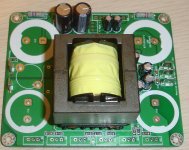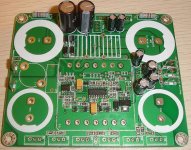The default caps for this board are 680uF at 200V. the ones which are on your board are 820uF at 200V. higher capacitance have benefic impact on the performance. if you wish i can send you the default caps, 680uF. i thought that sending better caps will be appreciated
Cristi is resolving this for me - there was a problem with my order. Looking forward to getting this unit installed in my 1U case.
have you tried it already with your tk2050 amp ?Cristi is resolving this for me - there was a problem with my order. Looking forward to getting this unit installed in my 1U case.
have you tried it already with your tk2050 amp ?
Alas, I fried my old TK2050 amp. Should have been more careful. I'm waiting for a replacement from Hifimediy - the new T1 with the sta510a chip. I'll post in the Hifimediy TK2050 thread when it's up and running.
I was thinking of getting the ClassD Audio sds 254 or sds 258 amps.
Which SMPS PS would you recommend to get the best performance?
Also do you have noise specs, ripple etc for your SMPS?
Thanks
The most suitable power supply is SMPS500R. the output voltage can be set to the value which you need. being soft-switched, the radiated and conducted noise is much lower than for a similar power hard-switched smps. output voltage ripple is below 100mV for +-60V version. note that a good linear regulated power supply have similar value. an unregulated one, bridge+transformer has few V up to 10+ V ripple.
Does this document help ? http://www.connexelectronic.com/documents/SMPS500R.pdfHi
worked through the thread but was not able to find any spec on line and load regulation ???
I'm especially interested in the SMPS500R 48V / single out version.
Michael
Michael,
The SMPS500R both single and dual output has line and load regulation below 1%. this means that the output voltage variation from zero load to 100% load will not drop or increase with more than 1%. typical values which i measured are ~220mV for the +-54V one, ~190mV for 48V single one, ~120mV for 24V single one. output ripple is also below 200mV for >35V versions and below 100-150mV for lower output voltage ones.
Off course the ripple values can be improved by using an additional LC filter, on each rail. this will increase the size, weight and cost, and i would say that without major improvements in the sound quality of the amplifier. the main feature of this power supplies is the small size, high efficiency and reasonable price. if there will be request for an "ultimate" smps, i will consider doing that too. but at least one of the above listed features will suffer for this purpose. having a non-ideal power supply is not the end of the word for any amplifier, which will use it's PSRR characteristic to further improve what goes out to the speakers. at the end, the classical power supply made of mains transformer, rectifier, capacitors, cannot claim better performances when it comes to ripple and load regulation. of course can be better than a poorly designed smps with unregulated output, and without EMI filters.
Regarding your power demand of 1000W at +-48V, if you are looking for a low noise, low footprint, high efficiency SMPS, i suggest to chose a SMPS800R which can provide this power as peak power, and since the amplifier does not require continuous power would do the job.
Regarding split GND, well, is not something very common, at least among regulated output smps's. mainly because the regulation will be more complicated, the smps will have equivalent of two independent outputs, which then you connect them together. something similar with the common ATX PC supply. using short, thick GND connection can lead to same result.
I don't see an obvious reason why one would try to avoid any potential loop on the GND of the power supply to amp only, since there is no low-signal involved to create noise. of course the input signal and output to speakers GND should be connected to the amplifier board GND not smps GND.
The SMPS500R both single and dual output has line and load regulation below 1%. this means that the output voltage variation from zero load to 100% load will not drop or increase with more than 1%. typical values which i measured are ~220mV for the +-54V one, ~190mV for 48V single one, ~120mV for 24V single one. output ripple is also below 200mV for >35V versions and below 100-150mV for lower output voltage ones.
Off course the ripple values can be improved by using an additional LC filter, on each rail. this will increase the size, weight and cost, and i would say that without major improvements in the sound quality of the amplifier. the main feature of this power supplies is the small size, high efficiency and reasonable price. if there will be request for an "ultimate" smps, i will consider doing that too. but at least one of the above listed features will suffer for this purpose. having a non-ideal power supply is not the end of the word for any amplifier, which will use it's PSRR characteristic to further improve what goes out to the speakers. at the end, the classical power supply made of mains transformer, rectifier, capacitors, cannot claim better performances when it comes to ripple and load regulation. of course can be better than a poorly designed smps with unregulated output, and without EMI filters.
Regarding your power demand of 1000W at +-48V, if you are looking for a low noise, low footprint, high efficiency SMPS, i suggest to chose a SMPS800R which can provide this power as peak power, and since the amplifier does not require continuous power would do the job.
Regarding split GND, well, is not something very common, at least among regulated output smps's. mainly because the regulation will be more complicated, the smps will have equivalent of two independent outputs, which then you connect them together. something similar with the common ATX PC supply. using short, thick GND connection can lead to same result.
I don't see an obvious reason why one would try to avoid any potential loop on the GND of the power supply to amp only, since there is no low-signal involved to create noise. of course the input signal and output to speakers GND should be connected to the amplifier board GND not smps GND.
For a starter this sounds good regarding load and line reglation - why not including in the PDF?
Regarding split GND - well - I know what I usually do is "not common" (almost never is ).
).
As much as I agree to the points you brought up, and as much I was looking at the topic form even more perspectives - my long time experience simply stays - to some extent - in disharmony to common technical explanations.
So, as I rather use to follow my solid practical experience than nice theories (even my own ones ) I'll stick to my PSU layout.
) I'll stick to my PSU layout.
The choice I have - as it seems - is to either go with two single supply or - with a dual for which you can tell me where exactly I can cut traces...

Should not be any big deal, as telling from the SMPS800 single, there is no feedback loop taken from the secondary - no ?!?
To design a new board for such extravagant users like me seems to be overkill (though I'm at around a six way active - at the moment)
Michael
Regarding split GND - well - I know what I usually do is "not common" (almost never is
As much as I agree to the points you brought up, and as much I was looking at the topic form even more perspectives - my long time experience simply stays - to some extent - in disharmony to common technical explanations.
So, as I rather use to follow my solid practical experience than nice theories (even my own ones
The choice I have - as it seems - is to either go with two single supply or - with a dual for which you can tell me where exactly I can cut traces...
Should not be any big deal, as telling from the SMPS800 single, there is no feedback loop taken from the secondary - no ?!?
To design a new board for such extravagant users like me seems to be overkill (though I'm at around a six way active - at the moment)
Michael
Last edited:
As i wrote on your PM, i'm thinking to make a new version, which will have multiple isolated outputs, giving freedom to the user to connect them as he wish, series parallel, or whatever combination. regulation will be done in the primary side, not secondary as the actual ones have. the main drawback, which i must figure out how to solve will be to reduce the voltage unbalance between outputs when these will be uneven loaded.
as soon as i find some time, i start to dig&play with...
as soon as i find some time, i start to dig&play with...
- Status
- This old topic is closed. If you want to reopen this topic, contact a moderator using the "Report Post" button.
- Home
- More Vendors...
- Connexelectronic
- Switched Mode Power Supplies (SMPS)

